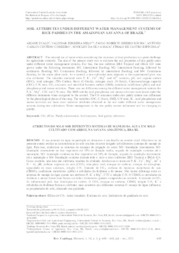Soil attributes under different water management systems of rice paddies in the Amazonian Savanna of Brazil.
Soil attributes under different water management systems of rice paddies in the Amazonian Savanna of Brazil.
Autoria: EVALD, A.; MELO, V. F.; ROCHA, P. R. R.; CORDEIRO, A. C. C.; MAIA, S. da S.; ESPINDOLA, I. DE C.
Resumo: The rational use of water while considering the increases in food production is a great challenge for agriculture currently. The aim of the present study was to evaluate the soil properties of rice paddy areas under different water management systems. For this, the rice cultivars BRS Tropical and IRGA 424 were grown under the following treatments: M1: Intermittent flooding; M2: Intermittent flooding, followed by continuous flooding; M3: Continuous flooding, followed by intermittent flooding; and M4: Continuous flooding for the entire plant cycle. As a control, a non-cultivated area, adjacent to the experimental plots was also evaluated. The variables analyzed were P, K+, Ca2+, Mg2+ and Al3+ contents, pH, soil organic carbon (SOC), total nitrogen (TN) Carbon Stock (C-Stock), nitrogen stock (N-Stock), Cation-exchange capacity (CEC), C/N ratio; CO2 emission, soil microbial biomass carbon (SMB), metabolic coefficient (qMic) and acid phosphatase and urease activities. There was not difference among the different water management systems for P, K+, Mg2+, CEC and C/N ratio. The SMB and the acid phosphatase and urease activities were lower under the different treatments when compared to the control. The CO2 emission under rice paddy system was influenced by the phenological phase of the crop. The variables SOC, C-Stock, SMB, C/N ratio, K+, acid phosphatase and usease activities are those most sensitive attributes observed in the soil under different water management systems during rice cultivation. Water management in the rice paddy system influenced soil by changing its quality.
Ano de publicação: 2021
Tipo de publicação: Artigo de periódico
Unidade: Embrapa Roraima
Palavras-chave: CO2 efflux, Paddy environment, Soil quality indicators
Observações
1 - Por padrão são exibidas publicações dos últimos 20 anos. Para encontrar publicações mais antigas, configure o filtro ano de publicação, colocando o ano a partir do qual você deseja encontrar publicações. O filtro está na coluna da esquerda na busca acima.
2 - Para ler algumas publicações da Embrapa (apenas as que estão em formato ePub), é necessário ter, no celular ou computador, um desses softwares gratuitos. Sistemas Android: Google Play Livros; IOS: iBooks; Windows e Linux: software Calibre.
Acesse outras publicações
Acesse a Base de Dados da Pesquisa Agropecuária (BDPA) para consultar o acervo completo das bibliotecas da Embrapa.

